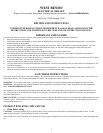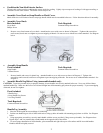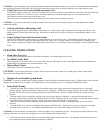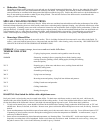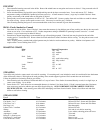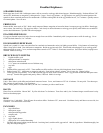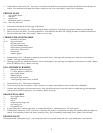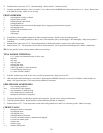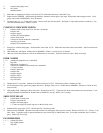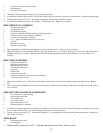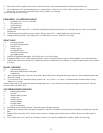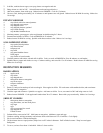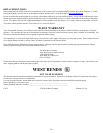4
CAUTION: To prevent personal injury or property damage, handle the heat control carefully if you remove it from the product immediately
after cooking because the metal probe will be hot—do not touch the metal probe or let it touch anything or any surface that may burn.
• Using Glass Cover as a Casserole Dish (not metal cover)
If your skillet features a glass cover, it may be inverted for use as a casserole dish in a conventional or convection oven up to preheated
temperatures of 400°F or in a microwave oven. If casserole should be covered during baking in oven, use aluminum foil in
conventional ovens and plastic wrap in microwave oven.
Do not use glass cover under broiler or in browning unit or in a toaster oven as breakage can occur.
CAUTION: To prevent personal injury or property damage, do not use glass cover on range top unit as it could shatter due to sudden
temperature change.
• Cooking with Butter, Shortening or Oil
Foods may be prepared with or without butter, shortening or oil. When frying, using a small amount will improve the flavor, color
and/or crispness of meat, fish, poultry and eggs. Meat may be cooked in its own juices if skillet is covered and heat control is set at
SIMMER.
• Using Cooking Tools on the Non-Stick Surface
Plastic, rubber and wooden cooking tools are recommended for use on non-stick surface. Smooth-edged metal cooking tools may be
used with care. However, do not use sharp-edged metal tools (forks, knives, mashers, beaters or food choppers) as scratching may
occur. Minor scratching will affect only the appearance of the surface; it will not harm its non-stick property or the food prepared in the
skillet
.
CLEANING INSTRUCTIONS
• Clean After Every Use
To keep your skillet looking attractive and cooking efficiently, clean it thoroughly after each use.
• Let Skillet Cool by Itself
After using skillet, let it cool by itself. Do not pour cold water into skillet while it is hot. Although made of extra-thick aluminum a
sudden change in temperature may cause the metal to warp.
• Remove Heat Control
After skillet has cooled, remove the heat control.
CAUTION: To prevent personal injury or electric shock, do not immerse heat control, its cord and plug in water or other liquid.
Wipe clean with a damp cloth if necessary.
• Retighten Loose Handle/Legs and Knobs
CAUTION: To prevent personal injury or property damage, check, skillet for loose handles after each use. Retighten loose screws with the
appropriate tool, but do not over-tighten. Over-tightening can result in stripping of screw or cracking of handle/leg or knobs.
• In-the-Sink Cleaning
1. Clean the non-stick interior surface of the skillet with hot soapy water, using a non-metal cleaning pad such as a Scrunge®
Scrubber Sponge, Dobie® Scotch-Brite Cookware Scrub ‘n Sponge®. A dishcloth or sponge may give the non-stick surface a clean
look but will not remove the tiny food particles that can settle in the finish. Do not use metal scouring pads or harsh scouring
powders.
2. Clean the exterior finish of the skillet with hot soapy water using a sponge or dishcloth. A non-metal cleaning pad such as
Scrunge® Scurbber Sponge, Dobie® Scotch-Brite Cookware Scrub ‘n Sponge® and/or a non-abrasive cleaner such as Bon Ami® or
Copper Glow® may be used if necessary. Do not use metal scouring pads or harsh scouring powders.
3. Clean the non-coated aluminum underside of the skillet with a nylon or metal pad. A cleaning powder may also be used if
necessary.
4. Clean the skillet cover and rack, if included, with a sponge or dishcloth only. Do not use any type of scouring pad or cleaning
powder on glass or metal cover. The aluminum underside of the cover may discolor during use, which is normal.
CAUTION: Do not use abrasive scouring pads or cleaners on glass cover as scratching can occur. Scratching can weaken glass and cause
breakage when used. Be careful not to drop glass cover or hit it sharply with cooking utensils.
5. After washing, always rinse the skillet, cover and rack thoroughly with clear hot water. Any detergent left on the skillet or cover
after cleaning can cause staining when the appliance is reheated.



